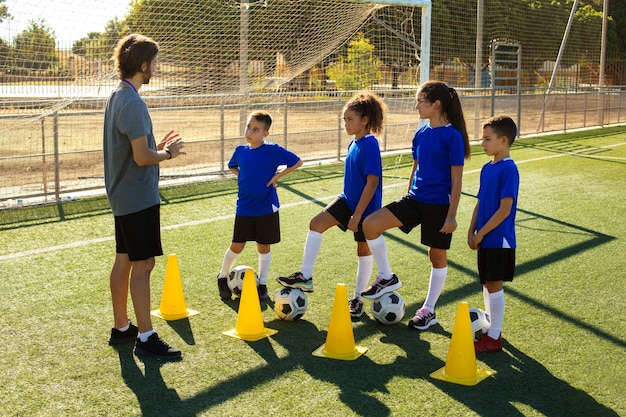Anúncios
As a longtime enthusiast of youth football programs, I’ve witnessed firsthand the profound impact that beginner drills can have on young players. When I think about the countless hours spent on the field, it’s clear how these structured activities foster not only essential skills but also crucial confidence. I truly believe that engaging in youth football drills for beginners is more than just an exercise; it’s a pathway to personal growth.
Structured drills provide a fun and supportive environment where players can experiment, learn, and thrive. The benefits are immense: not only do these exercises hone technical ability, but they also cultivate teamwork and resilience. This positive atmosphere equips players with the tools they need to excel on and off the field, paving the way for a love of the game that lasts a lifetime.
Anúncios
Importance of Youth Football Programs
Top Youth Football Drills for Beginners
When starting in youth football, mastering fundamental skills is crucial. Here are essential drills tailored for beginners, each designed to enhance specific techniques while still being adaptable for varying skill levels.
1. Dribbling Drills: The aim is to develop ball control and agility. Set up cones in a zigzag pattern. Players dribble the ball in and out of the cones using small touches. For variation, challenge them to use only their weaker foot or introduce different speed levels.
2. Passing Drills: Essential for team play, this drill involves players pairing up and practicing short passes. Focus on proper foot placement and follow-through. As skill improves, increase the distance between players or incorporate one-touch passing.
Anúncios
3. Shooting Drills: To refine accuracy and power, set up targets in the goal. Players take turns shooting from various angles. For a twist, introduce a defender or create time-limited shooting challenges to enhance pressure coping.
4. Defensive Positioning Drills: Teaching defensive fundamentals, this drill places a player in a one-on-one situation. One player tries to dribble past while the other practices positioning and tackling. Beginners can start stationary, then progress to moving scenarios.
5. Small-Sided Games: These are excellent for applying learned skills in a game-like scenario. Use a small field and limit the number of players to encourage involvement. Adjust the number of touches allowed or introduce a ‘no dribble’ rule to elevate the challenge.
These drills not only build foundational skills but also foster teamwork and confidence among young athletes. By incorporating variations, coaches can ensure that each player continues to develop at their own pace.
Essential Youth Football Drills Comparison
This table compares different youth football drills, outlining their key focus areas, required equipment, and skill levels to help coaches select the most suitable drills for their team.
| Drill Type | Focus Area | Required Equipment | Skill Level |
|---|---|---|---|
| Dribbling Drills | Ball control, agility | Cones | Beginner to Intermediate |
| Passing Drills | Team play, accuracy | Ball, cones | Beginner to Intermediate |
| Shooting Drills | Accuracy, power | Goals, targets | Beginner to Intermediate |
| Defensive Positioning Drills | Defense fundamentals | Ball | Beginner |
| Small-Sided Games | Game application | Ball, goals | All skill levels |
Tips for Coaches and Parents

Implementing youth football drills for beginners requires a strategic approach that fosters both skill development and a positive environment. Coaches and parents should prioritize open communication, providing clear instructions and expectations. This approach helps young athletes understand the purpose behind each drill, making the learning process engaging and enjoyable.
Encouraging collaboration amongst players during drills can also enhance social interaction and teamwork. Coaches should create small groups where athletes can provide feedback and support each other, instilling a sense of camaraderie. This not only improves performance but also boosts self-confidence and motivation.
Additionally, incorporating fun challenges or friendly competitions within drills can maintain high energy levels and enthusiasm. By celebrating small achievements and effort, coaches and parents can cultivate a resilient mindset, helping young players appreciate growth beyond mere results.
Success Stories and Benefits
Similarly, Mia, who began her journey with youth football drills at the age of 10, discovered a hidden talent for teamwork. Through consistent practice, she learned the importance of communication on the field, which helped her lead her team to a regional championship. These stories exemplify how youth football programs can foster personal growth, improve athletic skills, and build lasting friendships, ultimately shaping the future of young athletes.
Explore the Benefits of Youth Sports Programs
To understand how youth sports like football can impact personal development through teamwork and confidence-building, check out this insightful resource: Positive Coaching Alliance.